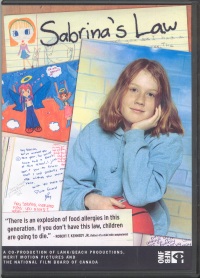| ________________
CM . . .
. Volume XV Number 14. . . .March 6, 2009 
 |
Sabrina's Law.
Barry Lank (Director). Bonnie Dickie (Writer). Luanne Lank, Merit Jensen-Carr & Derek Mazur (Producers).
Montreal, PQ: National Film Board of Canada, 2008.
43 min., DVD, $99.95.
Order Number: 153C 9107 346.
Subject Headings:
Food allergy in children-Complications.
Food allergies.
Behaviour disorders in children.
Grades 9 and up / Ages 14 and up.
Review by Frank Loreto.
**** /4
|
| |
|

A few staff meetings ago, we had to sit through another demonstration of the epi-pen. This was presented by video as item one of a lengthy list of agenda items. No one was particularly interested, and most were just eager for the video to end so the meeting could proceed. In Ontario, since the passing of Bill 3 or Sabrina's Law in 2005, such information is required by law in schools. Sabrina's Law, the film, would have made for much better viewing.
Sabrina Shannon was a vibrant 13-year-old who was highly allergic to a number of foods. She was aware of the dangers that lurked in many food products. She grew up with her condition and even created a segment for CBC radio's Out Front on what life was like being a kid surrounded by deadly foods to which most of her friends were immune.
One Friday, when she wanted to have French fries at her school cafeteria, Sabrina was careful to check that there was nothing in the fries that would hurt her - and there was not. She enjoyed them so much that she convinced her mother that she could have them again on Monday. Unfortunately, that day, the cafeteria served poutine. The tongs used to serve the poutine were also used to serve Sabrina her fries. The cheese residue on the tongs was enough to put her into anaphylaxis. Sabrina was dead within hours.
Sara Shannon, Sabrina's mother, was devastated by the loss of her daughter. Clearly the two had a tight bond as the film opens with Sara in Sabrina's room. All of Sabrina's things are still there, even the gym shirt she wore the day she died. Sara states that she can still smell Sabrina in that shirt. While Sara is initially shown as a mother who is unable to move past the death of her child, this presentation changes quickly. Following Sabrina's death, Sara has made it her mission to make sure that what happened to Sabrina would happen to no child ever again.
Sara is not alone in her quest. Robert Kennedy Jr. also has a child who is highly allergic to certain food products. He admits that he is unable to send his son to a birthday party, for fear that something at the party will kill him. After Sabrina's death, Sara made contact with Kennedy who has since become a friend and ally. Near the end of the film, Sara is shown receiving an award in New York which Kennedy presented. The warmth with which he introduces her shows that she has had in impact on his life.
In 2005, with complete assent, Ontario passed the Act to Protect Anaphylactic Pupils. Because of Sara's lobbying efforts, the government asked her if she would agree to the law being called Sabrina's Law. This victory alone was not enough to let Sara rest.
The film shows Sara as she travels throughout North America assisting groups who are trying to get similar laws passed in their various areas. While there are a million people in Canada with severe food allergies, the number in the United States is around 12 million. However, to date, Ontario alone has passed such legislation.
Sabrina's Law should be required viewing for all educators. Simply explaining the use of the epi-pen does not have the impact of showing why having this skill is so important. Sabrina did not have her pen with her that day. It was upstairs. Sabrina's Law shows why schools should be prepared for such incidents.
This film could be used in any number of classes—Parenting, Civics, Law, Health, Biology or just to show students the dangers of foods for some of their classmates.
Highly Recommended.
Frank Loreto is a teacher-librarian at St. Thomas Aquinas Secondary School in Brampton, ON.

To comment
on this title or this review, send mail to cm@umanitoba.ca.
Copyright © the Manitoba Library Association. Reproduction for personal
use is permitted only if this copyright notice is maintained. Any
other reproduction is prohibited without permission.
NEXT REVIEW |
TABLE OF CONTENTS FOR THIS ISSUE
- March 6, 2009.
AUTHORS |
TITLES |
MEDIA REVIEWS |
PROFILES |
BACK ISSUES |
SEARCH |
CMARCHIVE |
HOME |
